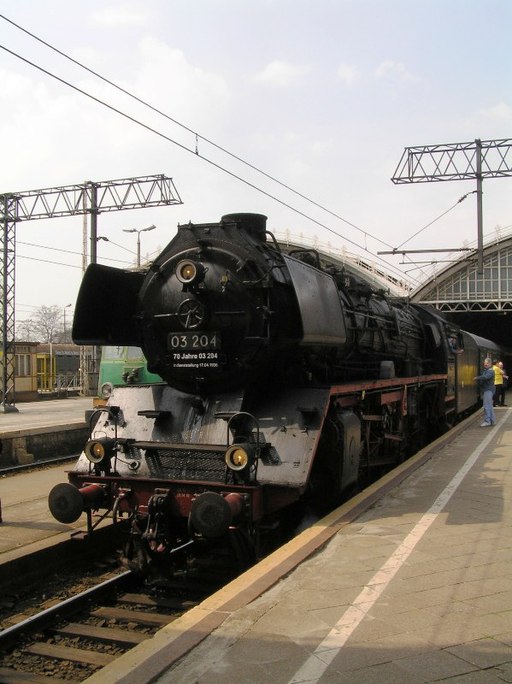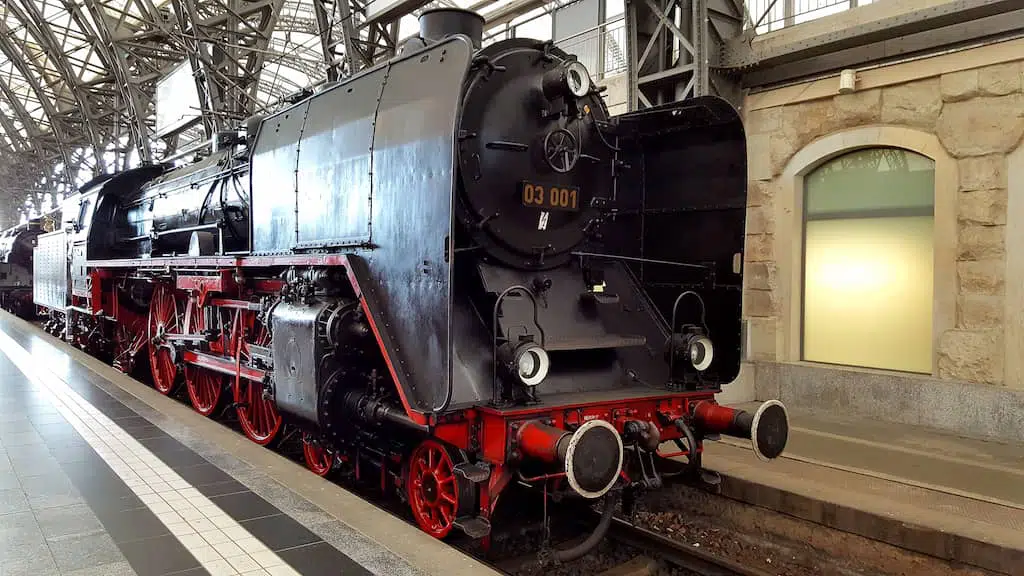DRG Class 03 - The express locomotive of the DR
The DRG class 03 steam locomotives were standard express locomotives of the Deutsche Reichsbahn. In terms of design, these locomotives were similar to the class 01. They had a lower wheelset load with a maximum of 18 t than the class 01.
The Class 03 steam locomotive was built between 1930 and 1938 as an express train locomotive for lines suitable for a maximum wheelset load of 18 t. A total of 298 examples of this locomotive were produced by the companies Borsig, Krupp, Henschel and Schwartzkopff.
| Manufacturer: | Borsig, Henschel, Krupp, Schwartzkopff |
| Length: | 23,905 mm |
| Numbering: | 03 001-298 |
| Weight: | 99.6t (03 001-122), 100.3t (03 123-298) |
| Years of construction: | 1930-1938 |
| Top speed: | 120/130km/h forward, 50 km/h reverse |
| Retirement: | 1966 (03 1001 - 1084), later followed by other machines |
| Fuel supply: | 10.0 t hard coal |
| Water supply: | 30.0/32.0/34.0 m³ |
| Number: | 298 |
| Power: | 1456 kW |
| Train heating: | Steam |
| Boileroverpressure: | 16 bar |
| Grade: | S36.17 (03 001-122) S36.18 (03 123-298) |
| Type: | 2'C1' h2 |
| Interesting facts |
|---|
| The steam locomotive DRG Class 03, like the 01, belongs to the type 2'C 1' h2. They have 2 successive running axles united in one bogie, independent of the main frame, and 1 running axle independent of the main frame. The steam type is superheated steam and the engines have 2 cylinders. More interesting facts |
The history of the steam locomotive DRG Class 03
In contrast to Class 01, DRG Class 03 has a lower mass. This was achieved with a lighter ingot frame, a smaller boiler and smaller cylinders. The pumps were placed in the middle of the vehicle starting with road number 03 123. From road number 163 on, the class 03 locomotives had bogies with wheels with a diameter of 1000 mm instead of 850 mm. The first 122 locomotives were approved for a maximum speed of 120 km/h. After a few years, the vehicles were raised to a speed of 130 km/h during test runs at the Grunewald locomotive test centre. The locomotives from 03 123 onwards were already approved ex works for this speed.
The DRG Class 03 locomotives were characterised by a low specific steam consumption value in relation to the indicated power. The value is 6.32 kg/PSh. The vehicles also showed low values in coal consumption of 0.86 kg/PSih, compared to the P 38 series with 0.96 kg/PSih, the 01 series with 0.93 kg/PSih, and the S 3/6 series with 0.88 kg/PSih.
The locomotive with the road number 03 154 was equipped with a parabolic smoke chamber door, a streamlined driver’s cab and engine cowling. In order to have an approximately equivalent replacement engine to the two BR 05 models, it was decided to equip the 03 193 with a wine-red streamlined fairing and the tender 2’3 T37St. The streamlined cladding enabled the tow hook performance to be increased by up to 48% at high speeds.
The 03 204 and 205 also received an engine cowling on a trial basis. The 03 175 and 207 locomotives were fitted with a Lentz valve control for test purposes. The locomotives of this series were coupled with trailing tenders of the types 2’2 T30, 2’2 T32 and 2’2 T34. These tenders were already used in the 01 series.
After the Second World War 36 locomotives were delivered to the Polish State Railways PKP. They were run as class Pm2 and were decommissioned until 1978. Approximately 29 locomotives remained in the Soviet Union. The 03 113 was used in Austria until 1952 and later handed over to the DB. Most of the steam locomotives class 03, which were taken over by foreign administrations, lost the piston feed pump with preheater in favour of a second jet pump.
By 1959 the German Federal Railways had 145 DRG Class 03 locomotives in service.
62 machines (03 005 – 122) with air and feed pump in smoke chamber niches and small forerunner wheels with 850 mm diameter
16 machines (03 127 – 160) with pumps in the middle of the vehicle and small forerunner wheels with 850 mm diameter
67 machines (03 164 – 296) with pumps in the centre of the vehicle, scissor brakes and 1000 mm diameter front wheels
In 1968 there were still 45 locomotives of the now called class 003 in the stock. They were at home in the following depots:
2 in Braunschweig
6 in Bremen main station
13 in Hamburg-Altona
1 in Husum
16 in Mönchengladbach
7 in Ulm

From 1971 the last 10 steam locomotives of the class 003 were used by the DB from Ulm. In 1972 the last 003 088, 131 and 268 z were put into service.
There were 86 locomotives in service with the DR. From 1960 onwards the DR equipped the vehicles with mixing preheaters and rear boilers in welded design for repairs according to damage group L4. In contrast to the DB, which already retired its vehicles in the 1970s, the DR continued to use its vehicles in passenger train service. The steam locomotive BR 03 was stationed at the DR in the following depots, among others:
Berlin Osb
Frankfurt (Oder)
Hall P
South Leipzig
West Leipzig
Between 1969 and 1975, after the class 22 was taken out of service, a total of 55 DRG Class 03 locomotives were reconstructed using the combustion chamber boilers type 39 E, which were only a few years old. The difference between the reconstructed class 03 and the other locomotives of the same class was the sandbox at the steam dome.
The feed dome was no longer necessary with the reconstructed boilers, as the feed water treatment took place inside. Additionally the rear boiler had more washing hatches. A few vehicles were also equipped with brand-new boilers of the same type. Except for 03 001, the BR 03 steam locomotive was at least equipped with mixing preheaters and new rear boilers.
The recolocomotives of the BR 03 were not given new numbers, from 1972 03.2 onwards. In contrast to the other recolocomotive series. The BR 03 recolocomotives were not officially designated as reconstructed, as the reconstruction programme was considered to be finished from 1969 onwards.
The further development of the DRG Class 03 led to the class 03.10.

The original version of the steam locomotive DRG Class 03
The frames of the DRG Class 03 locomotives had an ingot frame with a cheek thickness of 90 instead of 100 mm. Identical in construction to the class 01. In the area of the towing frame the cheek thickness was reduced to 40 mm.
The riveted long tube boiler was equipped with copper fireboxes up to locomotive no. 03 122 and then with steel fireboxes. The boiler was capable of generating 12 t of steam per hour. A steam jet pump and a piston feed pump with surface preheater were installed as feeding devices.
The 03 series is equipped with two-cylinder hot steam engines, which were designed with a drive on the second coupling wheel set as propellant. The Heusinger control system was fitted with hanging irons. In the beginning angle valves were used as pressure compensators and later pressure compensating piston valves of the Nicolai or Karl Schulz type.
In the Class 03 steam locomotive, the domed wheel sets were fixed in the frame. The flanges at the wheel tyres were weakened by 15 mm. The running bogie was given a total of 100 mm of lateral shifting and the towing frame, designed as an Adam’s axle, a total of 160 mm.
The permissible speed of the locomotives was initially 120 km/h. This was increased to 130 km/h after strengthening the brakes and enlarging the wheel diameters to 1000 mm (from 03 163). Some machines were approved for the design speed of 140 km/h in the 1930s.
The DRG Class 03 locomotives were able to carry an express train with a mass of 430 t at 120 km/h and a train with a mass of 790 t at 100 km/h. On a gradient of 10 per mille, 480 t could still be carried at 50 km/h.
Characteristics of the Class 03 as a reconstruction locomotive at the DR
During the reconstruction of steam locomotive series 03, the welded new boiler type 39 E with combustion chamber, which was already used in series 41 and 22, was installed. Some of the boilers came from the class 22 locomotives that had already been taken out of service. This was capable of generating 14 t of steam per hour. 2 tons more than the boiler of the original design. A steam jet pump and a piston compound mixing pump with mixing preheater were installed to feed the boiler.
For the installation of the reco boiler only the standing boiler support had to be widened on the frame. The running gear and engine of the locomotives remained unchanged. The control stand was now no longer attached to the boiler but to the frame. In addition, Trofimoff type pressure compensation piston valves were installed.
Other minor changes were the installation of a sliding roof in the driver’s cab and the installation of the trapezoidal mixing preheater box on top of the smoke chamber. Which was probably the most visible change that had become necessary due to the more ready standing boiler. Added to this were the new driver’s cab pre-walls with narrower front windows (with transparent panels).
| Length: | 23,905 mm |
| Weight: | 101.363 t |
| Top speed: | 120/130km/h forward, 50 km/h reverse |
| Fuel supply: | 10.0 t hard coal |
| Water supply: | 34.0 m³ |
| Power: | 1544.5 kW |
| Train heating: | Steam |
| Boileroverpressure: | 16 bar |
| Tender: | 2'2' T34 |
| Type: | 2'C1' h2 |
